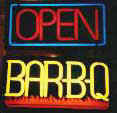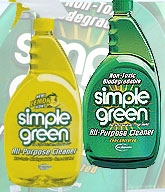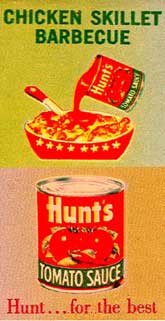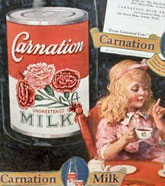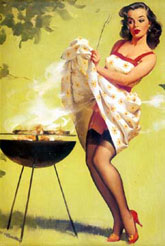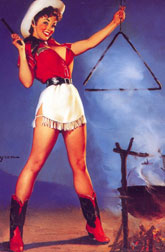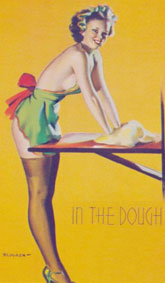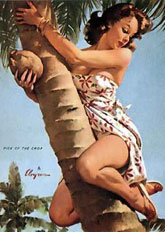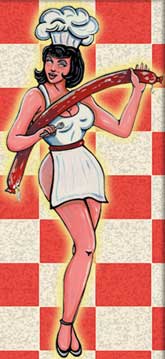Contact BBQbyDan
www.BBQDan.com
Search
KCBS BBQ Cook-Off Info
Recipes,
Smoking Meats
Recipes, Grilling
|
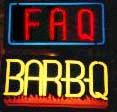 |
FAQ OF THE INTERNET BBQ LIST Version 2.0 Section 10.1.4 Pork Chops, Loins and Whole Hogs |
10.1.4 Pork chops and pork loins
--------------------[I've toughened up many a pork chop over the past year. Can anyone tell me how to slow smoke cook pork chops?]
Ed Pawlowski--
Pork chops are lean and that makes them touchy. A little too much heat and they are tough. I use chops at least 3/4" thick, an inch or a little more is even better. Keep an eye on them and take them off as soon as the internal temperature is high enough for them to be cooked. I go no more than about 155 to 160F.
==============Harry Jiles--
Thicker is definitely better for pork chops, especially loin chops. Ed is 100% correct about not over-cooking them. Pork chops are not forgiving about cooking a little longer than necessary. If you do as Ed says and monitor them closely as they approach getting done and take them off as soon as they are done you should get some great chops. Another trick you can try is to place them on a rack over a pan of water or other liquid. A broiler pan will work well for this. They will not take on as much smoke, but it will help keep them from drying out.
==============Kurt Lucas--
A simple but very tasty way to do pork chops is to get 3/4" thick chops and marinate them in olive oil, lots of sliced garlic and fresh thyme sprigs. Let them marinate for 24 to 48 hours. Remove from olive oil and wipe off the oil, thyme sprigs and garlic. Smoke at about 250-275F until just done (160F internal temperature). Once you try this you'll never want to do it any other way. I promise.
-------------------[How do I smoke a pork loin without making it dry?]
Bill Wight--
Give the pork loin a good dry rub for pork and add a good amount of paprika for a nice color. Wrap it in clear plastic and let it sit overnight in the refrigerator. Give the roast another sprinkling of the rub. Smoke it at 240-250F for about 3-4 hours. Use hickory, pecan or other strong-flavored wood for the smoke because the meat will not be in the smoker long. I use a Polder digital thermometer and take the meat off when it reaches 150F internal temperature. Let the meat sit on the counter for about 10 minutes before slicing and it will continue to cook to about 155F. At a temperature above 160F you've got yourself some dry pork.
==============Jeff Lippsit--
Honey, Mustard and Rosemary Pork Marinade
Amount |
Measure | Ingredient | Preparation Method |
3/4 |
cup | beer | |
1/2 |
cup | Dijon mustard | |
6 |
tablespoons | honey | |
1/4 |
cup | olive oil | |
2 |
tablespoons | rosemary, fresh | chopped |
2 |
tablespoons | garlic | chopped |
2 |
pounds | pork loin |
Whisk marinade ingredients and pour into a plastic freezer bag with the pork. Let sit overnight in the refrigerator.
Smoke the meat anyway you like it best. Take it out of the smoker at an internal temperature of no more than 150F. Let the meat stand for 15 minutes.
Heat the remaining marinade to a slow boil to thicken. Season with salt and pepper if desired. I cracked some pepper in it. Pour on the meat.
-------------------
[Any good recipes for grilled pork chops?]
Danny Gaulden--
I saw the Grillin' and Chillin' show and decided to try this recipe. It came out very tasty.
Grilled Pork Chops Adobo With Spicy Apple Chutney
Amount |
Measure | Ingredient | Preparation Method |
3 |
cups | adobo marinade | |
3 |
cups | spicy apple chutney | |
8 |
loin pork chops, | cut 1-inch thick |
The day before serving, pour the marinade over the pork chops, cover and refrigerate overnight. When ready to cook the pork chops, prepare a wood or charcoal fire and allow it to burn down to embers. Remove the chops from the marinade and reserve the marinade. Grill the chops for 5 minutes on each side, brushing with the marinade, until brown. Remove the chops to a serving platter. Serve immediately, topped with chutney to taste. Do not overcook!
Adobo Marinade
Amount |
Measure | Ingredient | Preparation Method |
2 |
cups | canned tomatoes | drained |
3 |
tablespoons | Ancho chile powder | |
3 |
tablespoons | New Mexico chile powder* | |
1 |
can | chipotle chiles, canned | seeded and diced |
1 |
tablespoon | honey | |
1 |
tablespoon | dark brown sugar | |
3 |
tablespoons | red wine vinegar | |
1 |
teaspoon | cayenne pepper powder | |
1/4 |
cup | garlic | chopped |
1/4 |
cup | olive oil |
Puree the marinade ingredients in a food processor. Yield: 3 cups
* Editor--The original recipe called for 3 tablespoons of Ancho chile powder and 3 tablespoons of Pascilla chile powder. There is some confusion in the world of chiles regarding the Ancho chile. Chileheads recognize the Ancho chile as the dried form of the red Pascilla chile. So following the original recipe would be just doubling the Ancho chile powder. New Mexico chile powder will give this recipe a nice blend of chile flavors. Adjust amounts of chile powder to suit your heat-level tolerance.
Spicy Apple Chutney
Amount |
Measure | Ingredient | Preparation Method |
2 |
medium | oranges | |
2 |
tablespoons | unsalted butter | |
1/2 |
cup | red onion | coarsely chopped |
1 |
tablespoon | jalapeno | minced |
2 |
tablespoons | ginger | finely diced |
2 |
cups | orange juice, fresh | |
2 |
tablespoons | vinegar | |
1/2 |
cup (packed) | light brown sugar | |
3 |
tablespoons | honey | |
8 |
Granny Smith apples | peeled, cored, sliced thinly | |
2 |
tablespoons | cilantro | finely chopped |
2 |
tablespoons |
red bell pepper | finely diced |
1 |
pinch | salt | |
1 |
pinch | black pepper to taste | freshly ground |
Peel the oranges, reserving the zest, and cut the flesh into segments. Set aside. In a large saucepan over medium heat, melt the butter and sauté the onion and jalapeno until the onion is translucent. Add the ginger, orange zest, orange juice, vinegar, brown sugar, and honey and cook until the sauce is reduced by half and has a glazed appearance. Reduce heat to low, add two thirds of the apple slices, and cook until the fruit is just tender. Turn off the heat and gently fold in the remaining apples and the orange segments. Pour the chutney into a bowl and allow to cool. Mix in the cilantro, red bell pepper, and salt and pepper to taste.
Source: TV Food Network GRILLIN' & CHILLIN' SHOW GR3626
-------------------
[Does anybody out there know how to make smoked Canadian bacon]
Brian Shafer--
Canadian Style Bacon (recipe will cure up to 25 lbs.)
Amount |
Measure | Ingredient | Preparation Method |
5 |
quarts | ice water 38-40F | |
6 |
ounces | dextrose | |
2 |
ounces | Prague Powder #1 | |
8 |
ounces | salt | |
25 |
pounds | pork loins |
Processing: Dissolve all the ingredients in water. The loins are then spray pumped to 10% of their green weight. Loins are then placed into the leftover brine and placed into cooler for 4-6 days at 38-40 F. Remove loins from the cooler and wash under a shower of cold water.
Smoking: Place in the smoker and smoke at 160F until an internal temperature of 142F is reached. Remove from smoker and cool with tap water until an internal temperature is reduced to 110F. Hang at room temperature until dry. Remove to cooler overnight before using.
Pea meal bacon: After curing, the loins are dried somewhat and coated generously with yellow cornmeal. They are then sliced and fried.
--------------------
[Can anybody tell me how to barbecue a whole hog?]
Rick Thead--
If you want to cook you hog on a horizontal cooker, the best way is to split the hogs spine. Your hog should have no hair on it if it came from a decent slaughterhouse.
Scrape all red things out of the body cavity, and trim the slits where the teats are--there is lots of fat here. On up towards the ribs is Bear's favorite piece, the bacon, so be careful how much you trim off. Start at the shoulder and work on back to the ham. Cut the 'brisket' out of the spare ribs area too, but keep all these trimmings for later. Now, place the hog on its back and take a hand hatchet and start chopping along the spine--working the ribs apart and away until the ribs will lay flat on the table.
Never pierce the skin, as it acts as a cooking pot for the pig to stew in its own juices. Rub the body all over, especially the inside, with Italian dressing and then some barbecue rub. Carefully create pouches under the skin of the shoulder and hams and rub good there too.
Take the trimmed skin and place back inside the hog's cavity, to act as an insulator. Add cut up onions, plums, apples, oranges, pineapples, whatever, inside the cavity also. Spray with Pam or other vegetable spray, all over the outside of the hog and the grill grate.
Place hog on hot smoker (250F at meat grate) and smoke heavily at 200F for three hours. If your firebox is to one side, place the tail nearest the firebox. The hams are the last to be finished, due to the thickness of the meat. Baste/mop with a liquid, whatever you wish to use. After smoking, switch to pure charcoal and raise heat to 230F. Now the trick with the hog is the unevenness of the meat, the hams and shoulders take longer than the head and ribs. So you bring out your trusty foil. Cover the mid-section and head with foil and allow the shoulders and hams to continue cooking unwrapped. Make a 'tent' not a tight wrap. A hog that goes on at 6 p.m. and foils at 9 p.m., should be ready to eat by 6 a.m. However, you want to really spike the hog temperature-wise about that time to about 150F (internal temperature) or so, to facilitate rendering the fat and then slowly allow the fire to die down.
If using the hog for onsite judging, garnish the grill all around the hog with fruit. Work off one side for preliminaries. If you make the finals, swap the hog around for a fresh looking hog, that does not look like it has been picked over.
Pull the hog off, set on a table and let everyone pick away!
If you can't fit the hog on your pit, cut it into quarters, and arrange as per above.
Oh, at the 6 a.m. spot, poke holes in cavity and allow rendered juices to drip away. Be prepared for about a half gallon of rendered juice. Your hog will be ready by 11:00 a.m. Assuming it is not a 200 pound hog, of course.
==============Patty Burke-Shelby---Tower Rock BBQ Team--
Here is how we do the Tower Rock BBQ "A Champion Hog
We start with a hog that is chosen from a small farmer here in southern Illinois and send it to our processor. He processes it to our specification of removing the skin and leaving on the head. We only cook fresh hogs. They are processed on Monday and we pick up on Thursday for the competition. We feel you get a better product using fresh meat. When we arrive at the competition site the preparation work begins. We work on a time schedule which takes a total of 26 hours. We start with a hog that dresses out around 120 pounds.
9:00 a.m. -- We remove the hog from the ice and trim the fat to a 1/4" thickness. Then we remove any debris left from the processing. Next, we split the back bone open just enough to make the hog lie flat but not so much as to lose all of its shape. We then sprinkle a little salt inside the body cavity, and on the outside (we use a sea salt for this). Then we add our special magic dust (rub) which is a combination of chili powder, red pepper, black pepper, white pepper, celery salt, garlic powder, brown sugar. Sorry, we keep the exact measurements a secret! After the preparation, we then secure a body rack to the cavity of the hog and a rack top and bottom the length of the hog.
11:00 a.m. -- The hog is then named (Philip Ingram Garcia) and loaded into the cooker belly down. The cooker was designed and built by my husband and my father. There are two baskets under the hog that are filled with 10 to 15 pounds of charcoal each, we only use a pure hickory charcoal with cornstarch binder and add about 1/2 gallon bucket of apple chips to the charcoal then we fire it with a propane torch - no lighter fluid! We bring the temperature up to 190F. We then bring the internal temperature of the hog up to 170F and hold there for approximately 4 hours. We use the old smoke house theory of meat will take on smoke when its cool. Once the temperature rises above 170F, the meat starts to cook outwards therefore no longer drawing the smoke in. After the 4 hours we start to raise the internal temperature of the hog to 185 to 190F. We maintain a 200F setting on the temperature of the cooker from here on out.
6:00 p.m. -- We then flip the hog to its back. This allows for the basting sauce to lay in the cavity of the hog. We baste every hour on the hour, up until 4:00 a.m. During this process we are checking that the internal temperature of the hog is OK and that the shoulders and hams are getting tender. We keep our baskets of coals under the shoulders and ham most of the time.
4:00 a.m. -- At this time we wrap foil around the head, and lay foil strips across the belly to keep it from darkening too much. We maintain a temperature at 200F in the cooker until 30 minutes before judging. Then we begin our ritual of removing the meat for the blind box and dressing the hog for a formal meeting with the judges.
-------------------[Can somebody tell me how to do a luau pig?]
Glenn Manning--
Luau pig is a bit labor intensive, but outstanding! Round up some large male friends and neighbors. Tell them to bring shovels. You go and buy about six cases of beer and some ice to keep it cold. About a half a case per male friend or neighbor with shovel--no shovel, no beer.
Prior to getting your friends and neighbors together, look around and find a source for very old, round river rocks that have not been in or around water in a long, long, geologic time. What you're trying to find is good cooking rocks, that won't explode when you heat them. You'll need about 15 to 30 the size of your head, depending on the size of the pig. You'll need some good hardwood, a big hunk of chicken wire fencing to go around and lift the pig, a small spool of stainless steel wire, lots of burlap bags, and banana leaves if you can find them. The leaves of "Elephant Ear" plants will also work, as these are a form of upland Taro. You'll also need one or two pieces of sheet metal big enough to cover the pit completely, and two pieces of plywood to go over the sheet metal. And some heavy gloves for everyone.
Once you've got the rocks, the neighbors, the beer, the small-to-medium pig, and a big pickup load supply of hardwood, (preferably mesquite, but any good cooking hardwood or fruitwood will do), assemble your friends and neighbors with shovels in your backyard and dig a hole. About 4 or 5 feet deep, and about 10 to 12 inches bigger than the pig all around.
Drink beer about 3 times during the digging if its a hot day. Now, at about 3 p.m., build a medium size fire in the bottom of the pit. When it's burning well, put in a bunch of your rocks around the fire, then start sliding pieces of your hardwood vertically into the bottom of the pit, all around the sides of the pit. Keep loading in wood, fairly fast, as it burns to coals, until you have a bed of red-hot coals about 1 to 1 1/2 feet deep.
Meanwhile, some of your other friends and neighbors have cleaned up the pig, (it has been gutted and the hair removed, right?), it is laying on layers of: 1) wet burlap, 2) banana leaves, 3) wet burlap, 4) chicken wire, 5) pig, on its back, legs in the air. Season the pig with about a cup of rock salt, and black pepper. Next step is to fish 3, 4, or 5 hot rocks, (whatever will fit), out of the fire pit, and place them inside the stomach cavity of the pig. Before putting in the rocks, punch some holes in the belly skin, on both sides so you can wire the belly skin together over the rocks. Working quickly now, fish the rest of the rocks out of the fire pit. Make a shallow depression in the coals with shovels or garden rakes, heaping some of the coals up the sides of the pit. Wrap the chicken wire, burlap, leaves and all around the pig, wrap and hold with wire. Leave the two edges of the chicken wire sticking up out of the burlap and leaves on top. These will be the handles you use to lower and raise the pig into and out of the pit; using rebar for handles.
It should now be late afternoon, early evening. Lower the pig into the bed of coals. Place the hot rocks around and pile on top of the pig. Rake coals over the sides of the pig. Cover the pit with the sheet metal, then put the plywood on top. The plywood is there to supply strength for the next step. If your sheet metal is fairly thick and heavy, (strong), you can forget the plywood. Now shovel dirt from the hole all around the pit to seal the edges of the sheet metal. Shovel about a half inch of dirt or more on top of the sheet metal for insulation. Drink more beer. All but 3 or 4 of your friends can go home now.
Get out some lawn chairs, set up a table, bring the TV out to the backyard, layout a couple sleeping bags, and take turns making sure nothing catches fire, (like the plywood), and not too much smoke and heat escapes.
Depending on the size of the pig, anytime from about 10 a.m. next morning and 2 p.m. next afternoon, have all your friends, and their families show up with their part of the potluck. Drinks, potato salad, poi if you like that sort of thing, fish dishes, Jell-O and dessert, (haupia cake). Carefully rake away and sweep away the dirt from the top of the pit. Remove the plywood and sheet metal. With rakes or shovels, gently pull away the coals and hot rocks from around the pig. With rakes, or hooks made out of rebar, about four guys grab both sides of the chicken wire and carefully heave the pig out of the pit. A wooden table is best at this point, and lots 'n lots of pots, bowls, and large containers; plus a garbage can to discard the bones. Open the chicken wire and pull it away from the pig. It is traditional in Hawaii that the guys who have done the hot, heavy work of cooking this pig, gets first choice of the crackly skin and meat that clings to the chicken wire. Using big cooking forks and the biggest knives in your arsenal, carve and rake the meat from the bones and put into the pots, bowls and containers. The meat should be so tender at this point, that it nearly falls from the bone.
During the carving, someone should take all the rocks out of the pit and then spray water into the pit to put out the fire. WARNING: Do not pour water on the hot rocks as they will shatter and explode. The rocks need to be taken out of the pit and set aside safely so no one gets burned on them. Save them for the next luau. Even watering the pit, the hole will be quite hot, so a couple guys should start filling it in with the dirt they took out yesterday.
Be very careful of the soil you do this in! Being an ex-pat Alaskan, I have first-hand knowledge and experience with underground fires that burn for years. Many of the Pacific Northwest and Northern areas are ancient, or contemporary but dried, peat bogs, and the ground burns! Please check with your local fire department before digging a hole and starting a fire.
-------------------[Can somebody tell me how to do a pig on a spit?]
Chuck Hersey--
For one or two 80 pound dressed pig carcasses, you will need a steel spit with six holes drilled through it per pig. You'll need a blowtorch to remove any hair on the skin, some baling wire and a wire cutter, a garden sprayer and a couple of gallons of white vinegar for a baste mixed 50:50 with water. I like to have the equivalent of a cord and a half of hardwood per pig. In might not require all that wood, unless a wind picks up. I like to have a couple of sheets of steel roofing (3' X 9'), to lie down sideways if it's windy, or stand up tent style over the meat if it rains.
Clean out the cavity of the pig. Burn off the extra hairs, pour boiling water over the nails until they loosen and remove them. Scrub the area under the nails, slit the eye socket once and remove the eyeball, prop the mouth open with a chunk of wood, so that it can be replaced later with an apple.
Drape the body cavity over the spit. Cut the end of the baling wire so that it has a sharp point. Push the wire through the shoulder then feed it through one hole in the spit, out through the other shoulder, and wrap around the body several times. The spit carries the pig as it rotates. Repeat this process down to the bent legs in back. You should have four spit holes filled. The bent back legs are attached to the spit through the last hole in the spit. The front legs and head are attached through the front most hole or holes in the spit. Keep the wire tight, as it will loosen just when the pig is about ready to come off and it's too late then to tighten it.
Burn down a few arm loads of wood to coals and put the spit at a suitable height on the stand. Suitable means high enough that if the pig is neglected for a while, the lack of slow turning does not result in burnt skin. Replenish the fire pit with wood to keep the coals.
The baste of water and vinegar is only necessary for folks who come by and want to help. Let them spray or turn the spit.
This process can take 24 - 36 hours if you are careful, and less if you are very attentive and much less if you use the roofing metal tent like
To know if the pig is done, stab the haunch with your index finger. If your finger doesn't penetrate the skin it's not ready. If your finger penetrates half way across the finger nail, it's still not ready. If you finger pierces up over the top of your nail, it's ready.
Another way to know if it's done is to pass a long tined fork between the back leg and the body, letting it rest there for a split second, then applying the fork tips to your wrist. If it burns your wrist, it's ready.
-------------------
[How can I smoke bacon at home?]
Editor--
Rick Thead has an excellent procedure with photos on his Web page for smoking
your own bacon ![]() Click here
Click here
Dan Gill also has directions for smoking bacon on his
smokehouse
Web page ![]() Click here
Click here
--------------------
[Can I smoke sausages in my smoker?]
Rock McNelly--
After you make or buy sausages, not much better you can do to them but smoke 'em. Put them on the top grill at 220F and give them about 1 to 2 hours, or until the sausage starts to sweat and form little beads of juice on its surface. When the beads cover the surface, the sausages are done, and any more time will start to dry them out. Time will depend on fat content so you'll have to experiment a little. Do them naked, or give them a pork dry rub. You can also marinade them, or give them a mop of beer and fruit juice. You can use any kind of sausage--the sky's the limit here. After you smoke the sausages, you can eat them right out of the smoker, or you can chop them up and put them in your barbecued beans. Chopped up and added to scrambled eggs and you got some kind of breakfast, fit even for a Texan. And here's something else, nothing tastes as good as homemade smoked sausage--much better than anything you can buy in the store.
--------------------
[Can I smoke hot dogs on my barbecue?]
Editor--
Sure. While you're doing that brisket, pork shoulder, ribs or whatever, throw a few (or a lot) hot dogs on the top grill and give them about 30-60 minutes in the smoke (you'll have to experiment a little in your smoker to get the perfect time). These will be the very best tasting hot dogs you've ever eaten.
You can download all the recipes in this FAQ ![]() Click here
Click here
Go to the next section
Return to the Table of Contents
Return to the BBQ FAQ Home Page
Comments or Suggestions
BBQ FAQ Ver 1.0, 2.0 ©1997, 1998 William W. Wight. All rights reserved.

